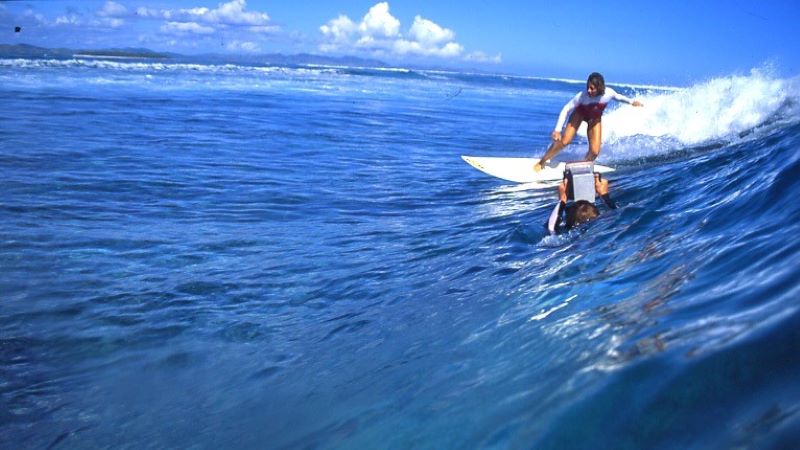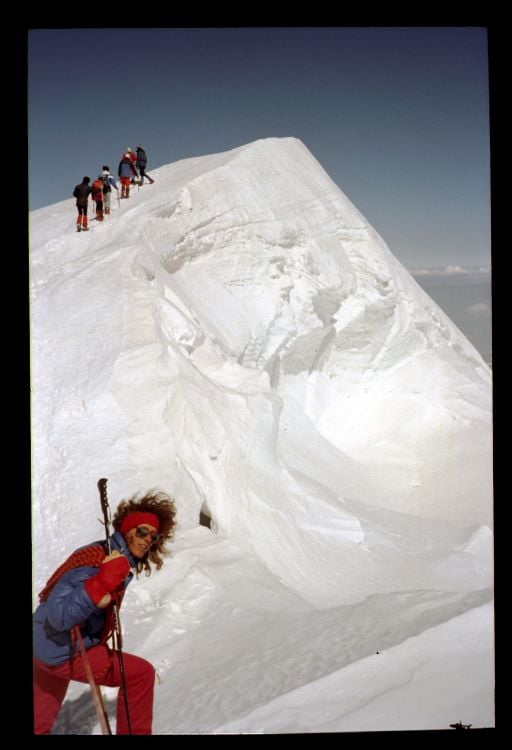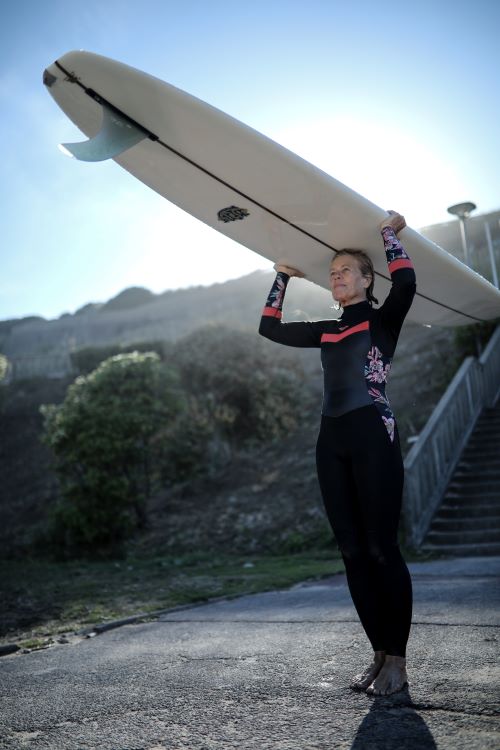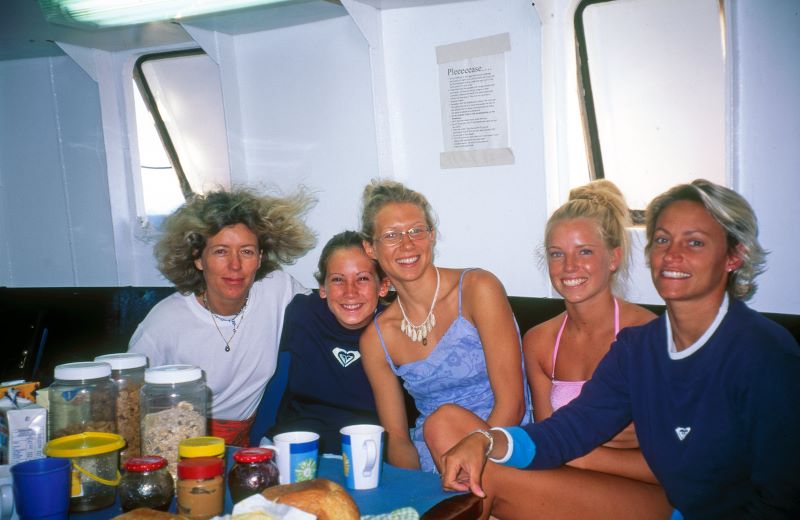
Big Wig: Roxy’s Co-Founder Maritxu Darrigrand
In the first of a series of 3 interviews with the key personalities behind the Roxy brand we talk to Maritxu Darrigrand, female icon of the surf industry and Co-Founder of the brand about the the early days and how the brand has evolved over the years.
Maritxu Darrigrand; adventurer, sportswoman, surfer, entrepreneur and truly one of the greatest women in our industry. A former French surfing champion, Darrigrand created the Nuits de la Glisse and was one of the pioneers who established the Quiksilver brand in Europe. Beginning with a simple swimwear line in 1990, she created Roxy. Today the brand dominates every aspect of the women’s boardsports industry. The first of its kind, it paved the way for all other female-specific surf/lifestyle companies. In the course of this development Darrigrand has been instrumental in the democratisation of women’s surfing and competitive snowboarding.
Maritxu, please tell us about your beginnings in the boardsports industry and what led you to working for Quiksilver.
I started my career by presenting surf movies at a time when the only possibility to watch a surf movie was going to a cinema in Biarritz. A bit later Yves Bessas and I decided to take the movies to the mountains and that’s how the concept of La Nuit de la Glisse began in 1979.
Around the same time we started going to California to look for surf movies. That’s how we met Alan Green and John Law, the founders of Quiksilver, who talked us into selling their boardshorts in Europe. As we had created Les Nuits de la Glisse, it made sense to start selling some surfing products as we were promoting a new lifestyle with the films.
So Yves, Jacques Albert and I had this business alongside the movies and we would receive boxes of boardshorts that we stored in the barn of the old farm where I was living. At that time we were also distributing Rip Curl wetsuits, Lightning Bolt Surfboards, and a t-shirt brand from California called Crazy Tshirt. That’s how it all started, in my house, in the French Basque country and from then it became what it is now, which is incredible.

How did Roxy come about?
I started working in marketing for Quiksilver in 1987 and while we were working on Quiksilver clothing, we pushed to make something more feminine, just having maybe a sexier t-shirt or a few things that we could also wear, but shaped in a different way from a men’s garment. What really helped was when Lisa Andersen got involved with Quiksilver and she needed to have a boardshort that was cut for a woman. And as soon as this boardshort came to the market, we saw that every girl wanted to have one. In the beginning, the name was still Quiksilver, then Quiksilver for girls but Alan Green didn’t want to be wearing Quiksilver, when it was worn by girls. So, we had to invent a name for this brand and created a great logo. And so, in 1990 we were the first people to launch a feminine surf brand.
What’s contributed to the success of the brand?
Soon after the creation of Roxy we could see that something was going on. I remember going to the beach in Bidart in winter and I would see young girls in the water in the winter. Something that never happened before. We could feel that a movement was starting and Lisa Andersen was a big part of it as she was a world champion from 1994 to 1997. She was good looking, she was a performer, she was great fun. She represented the brand extremely well.
Another development which really pushed Roxy in front of everybody’s eyes, is that we always used and still do, real surfer girls. We never use top models. We had these girls, all kinds of surfers, at different levels, surfing and playing in the water. Consumers could identify with these girls. This really pushed the brand forward. Another advantage was that we had no competition with other brands: we were launching everything. That’s when we started the stand-alone contests, focusing for the first time only on women and it was a really exciting time.
Please tell us more about those first stand alone events.
I started the Roxy Jam here in France – in Bidart – in 2006. In the beginning it was not really a contest but more a gathering of all our team riders, across action sports. We then moved to the Côte des Basques and the Roxy Jam became really big there. I had always wanted to mix sports, music and art because I thought they worked very well together. Sometimes there are no waves or the tide is wrong. At the Côte des Basques you cannot surf when it’s high tide, so to have this mix of energy was great.
Then we got involved in snowboarding in the same way. We were the first to organise a stand-alone women’s snowboarding event: the Chicken Jam in Austria in the 2004/2005 season. It also had a very strong impact. It was good because we were launching things and were doing things that nobody else had done before. For example, we had the Roxy boat, with pink sails, sailing round the world, looking insane, in the very masculine world of sailing competitions.

2021
How have Roxy‘s values changed over the years?
The values are the same, the girls are the same. At some points we’ve tried to go more fashion focused or tried to go in different directions but we realized, it’s not for us. We are a brand for girls who want to do sports. It’s a big market and many girls now practice sports, for example yoga, running, and obviously surfing. When you see the number of girls in the water now, it has really grown. It’s the same with riding in the winter. There are all these girls and I think the brand is there and we don’t have to reinvent the wheel, we have had the same core values since the beginning. There has been some ups and downs, but at the end you come back to what it was at the beginning and it is still valid. We have a really good story. We have been there for a long time and are pretty unique. That story is there and it still works.
How has the surfing landscape changed for both female professional brand employees and also athletes in your time in the industry?
It has improved a lot. In the beginning the ASP contest prize money for men was really high and women were not getting paid as much. But now the girls are surfing to another level and they’ve got access to much better waves. Before they always got to surf when the waves were not good – where and when the guys didn’t want to go. So getting the same prize money now is a huge achievement and the capability of the girls is incredible. They now have a surf contest at Pipeline. In the beginning they didn’t have these opportunities, most people would leave because the girls were left to surf in shitty waves. Now they give the girls access to the best waves, the product is there and money is there. So the value on both sides is really good and you see girls like Justine Dupont: many guys won’t do what she does. The improvement is radical, it’s been step by step since we started, but the progress is there to be seen.
I’m very stoked by what’s happening in girls surfing and I guess in other sports too, although there are not many sports with equivalent prize money. Now it’s much easier to be on the tour as a girl. Now the young girls have a coach and they have the other girls helping them and everything is much easier. I see improvement, a lot of improvement. But we still need more powerful women in leading positions in the industry. So there is still room for improvement.
Looking back at your career – what have been the highlights?
There have been quite a few, but most of all I had such a great team of people working with me and around me. All the girls were just like family, we had a very strong connection. The team was insane. We always had a good time together. It was work, but it didn’t really feel like work because we liked to be together, to travel together and we shared good times. Other important moments in my career were when we were launching things like the Roxy Jam. To see the impact and what people thought about it was so rewarding. Then obviously the trips, like going to G-Land in 1996/1997 and surfing with three world champions – Lisa Andersen, Rusty Keaulana, Kelly Slater. Just the four of us in the water with a photographer and perfect waves. The jungle. There are plenty of stories like that.
Looking back, it is just a joy for me now because it is great to have seen so much from the first delivery of boardshorts arriving at my house, to what’s happening now. So there’s plenty of good times, you forget the bad times, but you keep the good times. I’m not in the Boardriders European headquarters anymore, yet I still feel at home, which is quite insane.

What is your role now and your involvement with the brand?
I am retired from Roxy but I am still involved in the Keep a Breast collaboration which I launched with the Roxy Jam. As president of the Keep a Breast Foundation in Europe I am organising an exhibition in Biarritz this year. We have developed an application that explains how to self-examine. We are very focused on prevention as more and more girls in their thirties are getting breast cancer because of our modern lifestyles. So we have the exhibition, we are launching a book and the Roxy Keep a Breast T-Shirts in October. It’s my focus, it keeps me busy and at the same time I am still involved with Roxy and part of the family.







